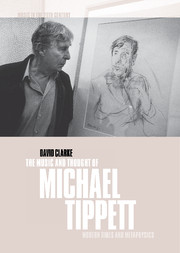Book contents
- Frontmatter
- Contents
- Acknowledgements
- References to Tippett's scores and essays
- 1 Tippett and the ‘world vision’ of modernity
- 2 The significance of the concept ‘image’ in Tippett's musical thought: a perspective from Jung
- 3 Back to Nietzsche? Transformations of the Dionysiac in The Midsummer Marriage and King Priam
- 4 Metaphysics in a cold climate: The Vision of Saint Augustine
- 5 ‘Shall we …? Affirm!’ The ironic and the sublime in The Mask of Time
- 6 The meaning of ‘lateness’: mediations of work, self and society in Tippett's Triple Concerto
- 7 The golden bird and the porcelain bowl: Byzantium and the politics of artefacts
- Notes
- Bibliography
- Index
2 - The significance of the concept ‘image’ in Tippett's musical thought: a perspective from Jung
Published online by Cambridge University Press: 13 October 2009
- Frontmatter
- Contents
- Acknowledgements
- References to Tippett's scores and essays
- 1 Tippett and the ‘world vision’ of modernity
- 2 The significance of the concept ‘image’ in Tippett's musical thought: a perspective from Jung
- 3 Back to Nietzsche? Transformations of the Dionysiac in The Midsummer Marriage and King Priam
- 4 Metaphysics in a cold climate: The Vision of Saint Augustine
- 5 ‘Shall we …? Affirm!’ The ironic and the sublime in The Mask of Time
- 6 The meaning of ‘lateness’: mediations of work, self and society in Tippett's Triple Concerto
- 7 The golden bird and the porcelain bowl: Byzantium and the politics of artefacts
- Notes
- Bibliography
- Index
Summary
Tippett and images
I know that my true function within a society which embraces all of us, is to continue an age-old tradition … This tradition is to create images from the depths of the imagination and to give them form whether visual, intellectual or musical. For it is only through images that the inner world communicates at all … Images of vigour for a decadent period, images of calm for one too violent. Images of reconciliation for worlds torn by division. And in an age of mediocrity and shattered dreams, images of abounding, generous, exuberant beauty.
For anyone seeking a statement epitomizing Tippett's stance as a composer (one only regrets that the promotional copy-writers got there first) the eloquent conclusion to the composer's essay ‘Poets in a barren age’ could hardly be bettered. It encapsulates his beliefs as to the essence of art and creativity, the role of the artist in society, and, implicitly, the nature of artistic material. The key term, repeated in nearly every sentence and worked into a compelling rhetoric, is ‘image’. For Tippett this seemed to be the essential vehicle of artistic communication, mediating between the inscrutable processes of the imagination and an all-too imperfect empirical reality.
- Type
- Chapter
- Information
- The Music and Thought of Michael TippettModern Times and Metaphysics, pp. 13 - 35Publisher: Cambridge University PressPrint publication year: 2001



